Cochinillo…crispy brown skin revealing juicy succulent meat underneath. Sometimes it’s dressed up with a fancy sauce; sometimes it’s seasoned with nothing but salt and the smoke of the fire. Either way, few things are more satisfying than the porky goodness of perfectly cooked cochinillo (suckling pig). It shows up frequently on the pages of this blog because if we see it on a menu, we’re usually getting it. So what exactly is cochinillo? Where can you find it in Valencia? And how can you make it at home in your oven?
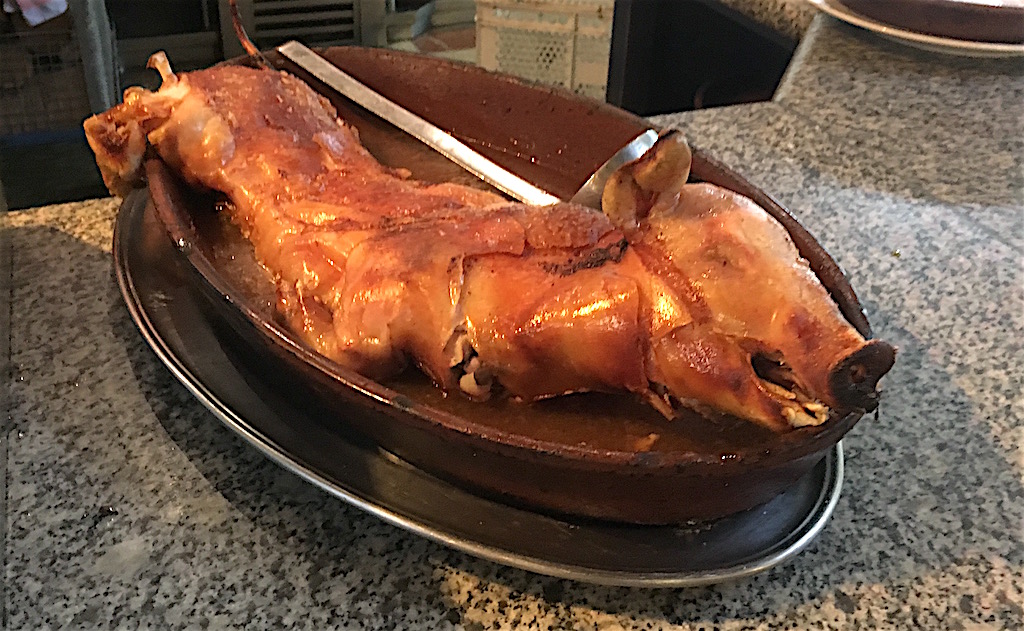
Cochinillo is the Spanish term for suckling pig. Technically, suckling pigs can be anywhere from 2 weeks to 6 weeks old and fed on nothing but mother’s milk. Since these little piglets haven’t had much time to work on their muscles, the meat remains incredibly tender and delicate. The young meat is also higher in collagen than mature pork, which is what gives it that wonderful sticky, gelatinous mouthfeel. I keep reading that suckling pig is low in fat and calories compared to other meat. I want to believe it, but my tastebuds tell me it just can’t be true.
Suckling pig can be found in cuisine from all over the world, particularly in European and Asian cultures. And why not? Humans domesticated pigs 9000 years ago! It can’t have taken long to figure out that the young ones were especially yummy. For some reason, in the United States it is a specialty item that costs top dollar. (Maybe it’s an American aversion to eating baby animals.) In Spain it is a classic dish found throughout the country. It is also popular in countries with Spanish influence. In Mexico, it is called lechón and used in many dishes.
Cochinillo is a traditional dish from Castile and León in Northern Spain, where the province of Segovia is the most well known region for its suckling pig and has very strict standards. Piglets must be no older than 3 weeks, fed only with mothers milk, and weigh between 4.5 and 6.5 kilograms (live weight) to bear the “Cochinillo de Segovia” IGP mark. It is traditionally roasted whole in a clay wood-fired oven, also called an horno de leña. The skin of the pig browns to a brittle crispiness, while the layer of fat under the skin melts away into the meat beneath, keeping it juicy. This is the way that you will find it prepared in classic asadors – restaurants that specialize in roasted meats.
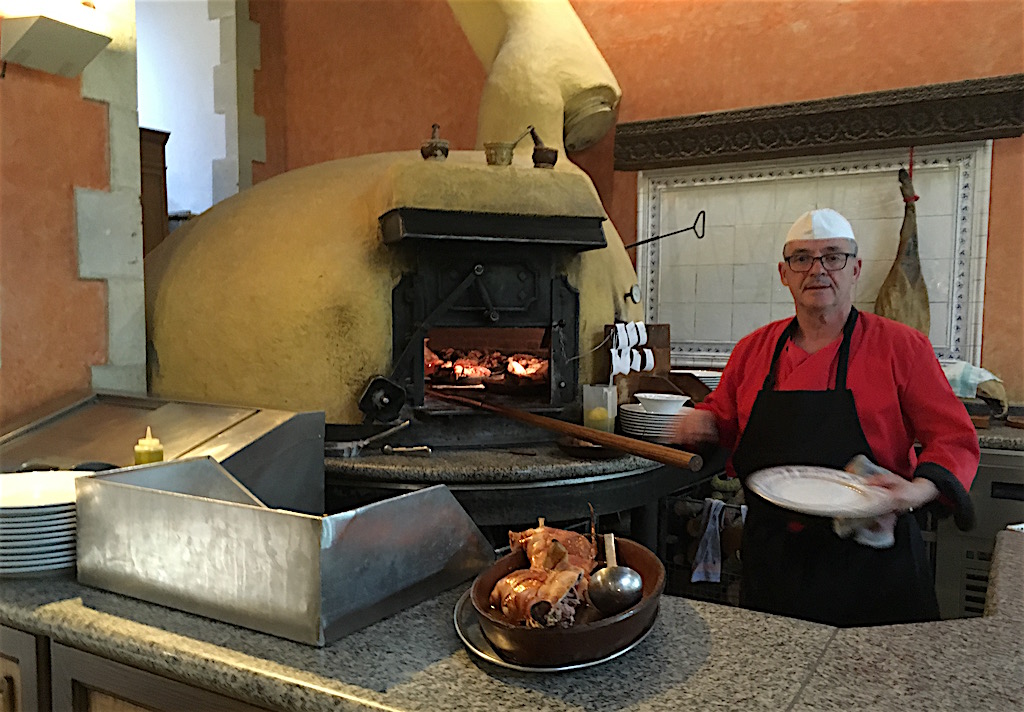
You can also find cochinillo at many of the many festivals that travel around Spain. When the Medieval market comes to town, or during the Christmas Fair, these guys are grilling whole pigs over wood coals. It is generally overpriced but it’s hard to resist the smell permeating the air. We’ve been suckered into an expensive plate of festival cochinillo and I recall being pretty happy about it.

Often you will see Taco de Cochinillo on a restaurant menu. This doesn’t necessarily mean suckling pig wrapped in a flour tortilla. In Spanish, taco also means “block” and it can refer to a preformed square of suckling pig meat. After roasting the pig, the meat is removed from the bones and pressed together into a block. A square of skin is cut and placed on top. This method presents a way to prepare the cochinillo in advance, a great convenience for restaurants without wood-fired ovens or for celebrations at home. The premade taco can be reheated and the skin crisped just before serving. Here is a recipe for tacos of Cochinillo de Segovia that could easily be made at home.
When possible, we prefer to have our cochinillo with a full bodied white wine, like Godello. It has enough body and acidity to stand up to the richness of suckling pig without overpowering the mildly flavored meat.
Cochinillo can be found in many restaurants around Valencia.
So now that you know a bit more about cochinillo, don’t be afraid to order it the next time you see it on the menu. These are just a few of the restaurants where we have enjoyed it.
The Asador de Aranda on Calle Feliz Pizcueta serves traditional Cochinillo lechal de IGP Segovia. The suckling pig is seasoned only with salt and roasted in a wood-fired clay oven in this classic Spanish restaurant. We ordered a 1/2 quarter of roasted suckling pig, which was considered a serving for one person but was plenty for the two of us to share. The skin was crisp and crackled open with the underlying fat layer melted away. The glistening meat easily pulled away from the bones. A bottle of the Pazo De Monterrey Godello paired nicely with the meal.
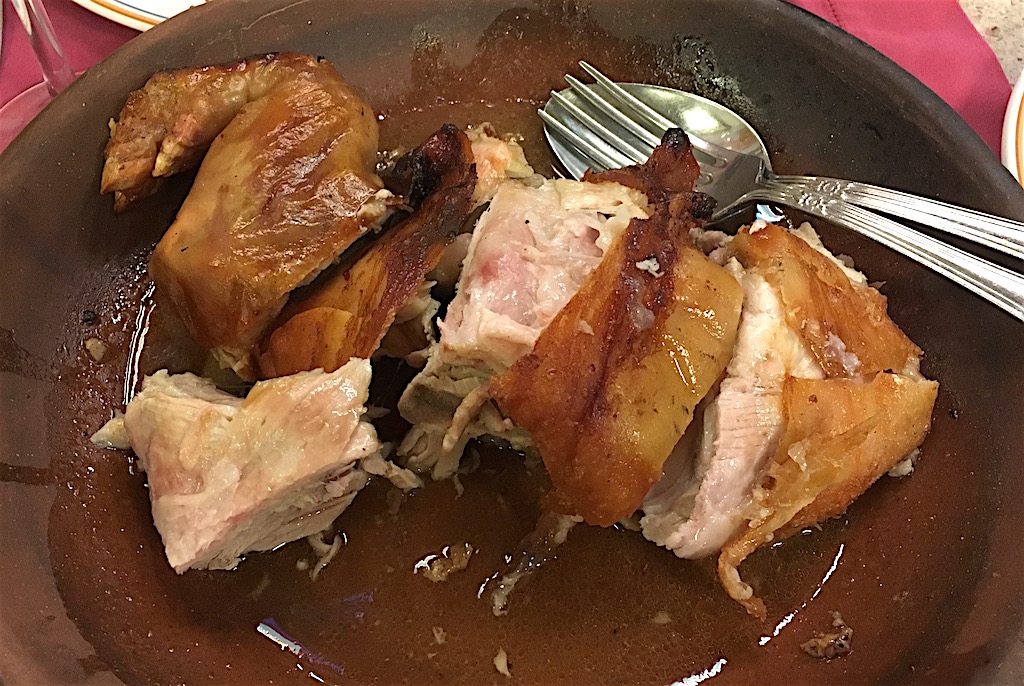
Racó del Turia on Calle Císcar in Canovas specializes in traditional Valencian cuisine, especially rice dishes. They do, however, also have a stellar cochinillo asado. The roasted suckling pig is served as a slab of tender, velvety boneless meat covered with a layer of crispy skin. The only sauce was from the meat’s own juices. It was accompanied by new potatoes and glazed shallots. Again, we selected a Godello left on its lees for more body from a terrific wine list of over 350 bottles. The decor of Raco del Turia is very elegant, with original oil paintings and Valencia ceramics hanging on the walls. It feels like you’ve been invited into someone’s home.
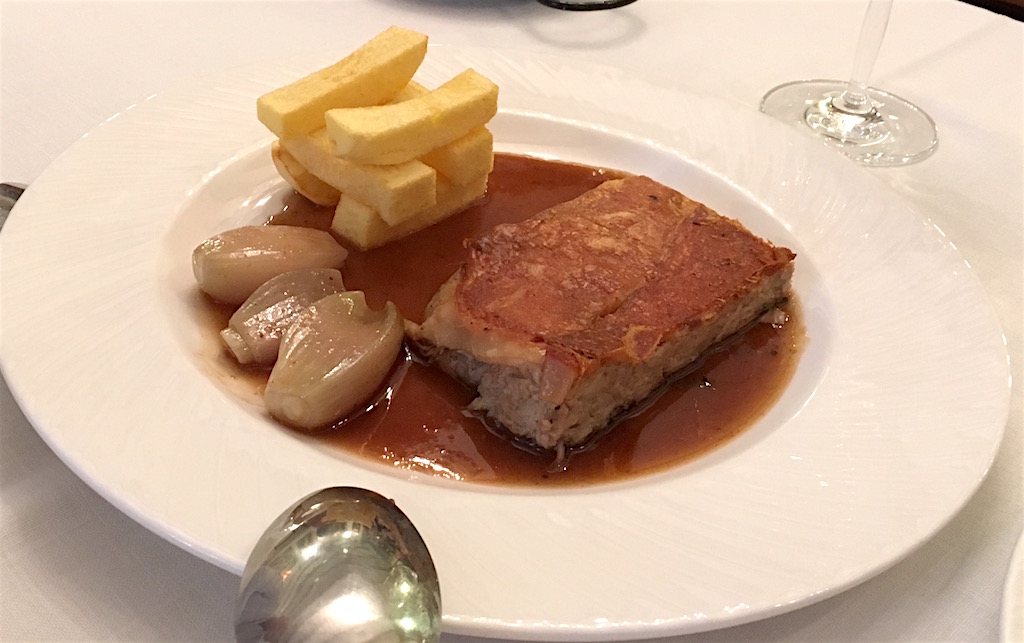
Also in Canovas on Calle Grabador Esteve, La Pureta Bistro is a charming little restaurant with white brick walls, a small terrace in the back, very friendly staff, and a big wine list. Their Taco de Cochinillo confitado is a block of shredded meat that has been cooked in oil, hence the term confitado. As hoped, the meat was tender and the square of skin on top crispy. It was served with a pumpkin puree with lots of intense molasses flavor. I really enjoyed swiping my cochinillo through the pumpkin, while my husband felt that the sweetness competed with the delicate pork. Fortunately, it was served to the side, so both of us were happy.
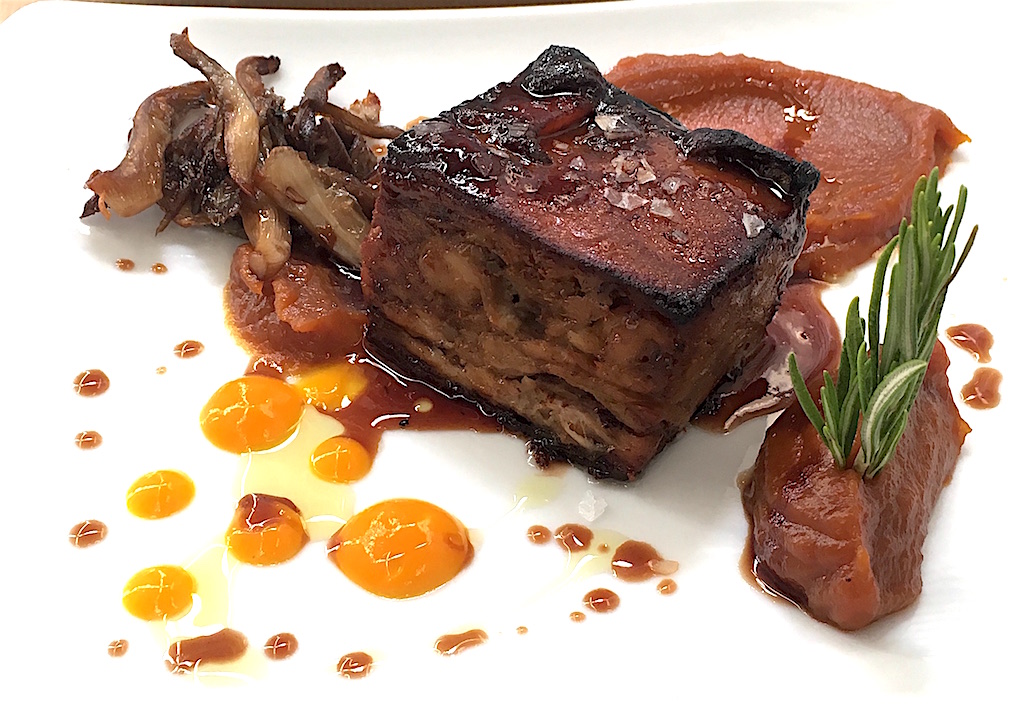
Orio Gastronomia Vasca is a Basque restaurant in the center of Valencia on Calle San Vicente Mártir. Orio is part of the Grupo Sagardi which began in Barcelona specializing in Basque cuisine. The cochinillo served at Orio is notable because it comes from a rare Basque breed of pig, called Euskal Txerria, that nearly went extinct. The Sagardi group has been involved in the recovery of this breed, serving it in some of their restaurants and using the meat to make their txistorra sausages and jamon. At Orio, the Euskal Txerria cochinillo is served as two tacos of meat “confit” with a layer of crisp skin on top. Each taco sat on a savory vegetable ratatouille. The meat is supposed to be lighter, more tender and juicy than other breeds. Without trying a side by side tasting with another pig breed, I couldn’t say how it was different. But it was definitely good, tender, and flavorful.
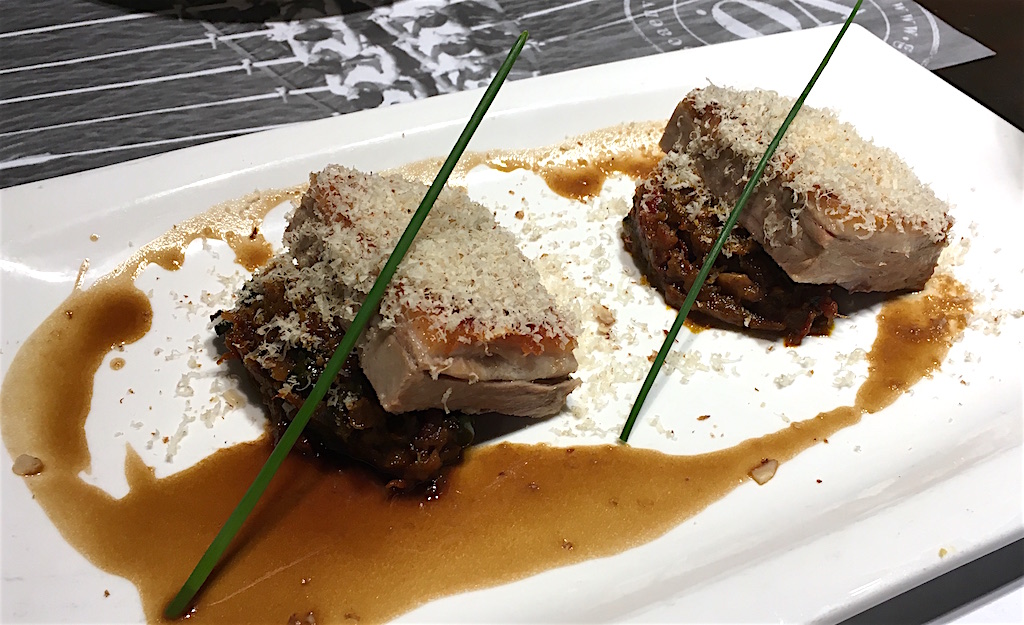
Roasting Cochinillo in your own kitchen
When we discovered suckling pigs shrink-wrapped in our neighborhood grocery store, we did what came naturally. We took one home and figured out how to roast it. They showed up in the local Mercadona and the El Corte Ingles Supermercado at the beginning of the Christmas holiday season. A Medio Cochinillo, a piglet that was cut in half from nose to tail, weighed about 3 kg (6.6 lbs). Some internet searching revealed that suckling pig is probably going to be delicious no matter how you bake it, as long as it fits in your oven. Achieving a crispy skin is the most difficult part.
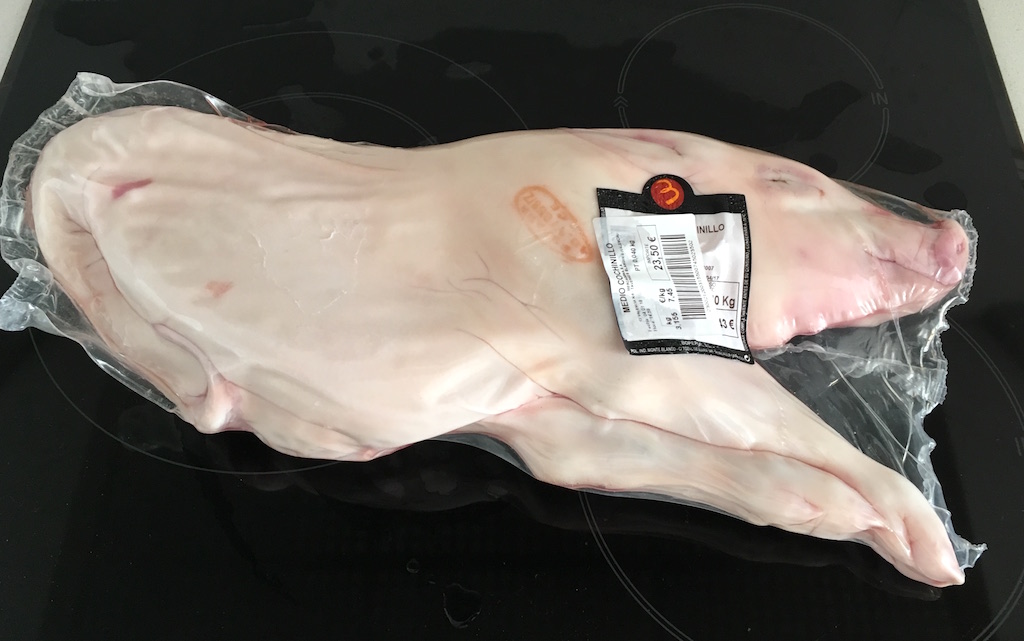
Since we don’t have a wood-fired oven, we stole a technique that we frequently use for roasting whole fish to impart some smokiness to the meat. First, we lined a baking rack with foil and poked holes to let the juices flow through into the roasting pan beneath it. We then built a bed of aromatic herbs using rosemary, thyme, and sage. The piglet was laid on top of the herbs, skin side up. We then rubbed the piglet all over with a mixture of salt, pepper, and garlic powder. The nose, ear, feet, and tail were covered with foil to protect them from burning.
We had no problem fitting the pig into our oven. We roasted it low and slow at 250°F for about 2.5 hours. Remove the foil from the appendages when there is about ½ hour cooking time left. During the roasting, the herbs beneath the pig begin to smoke, filling the oven (and the apartment) with the delightful aroma of wood smoke and herbs.
Watch the skin carefully along the way, looking for a dark golden brown and crispy texture. If you’re having trouble getting the skin crisp, crank the heat to 500°F and use the convection mode (if available) to crisp it up. Keep a good eye on it if you use this technique as you do not want the skin to burn.
We think the best way to serve whole roasted cochinillo is to move the entire pig onto a big platter and put it in the middle of the table. Let everyone dig in, pulling off pieces from various parts of the pig and using their fingers to get every last bite. This medio cochinillo was a good size for four people. However, we have been more than capable of taking care of it on our own.
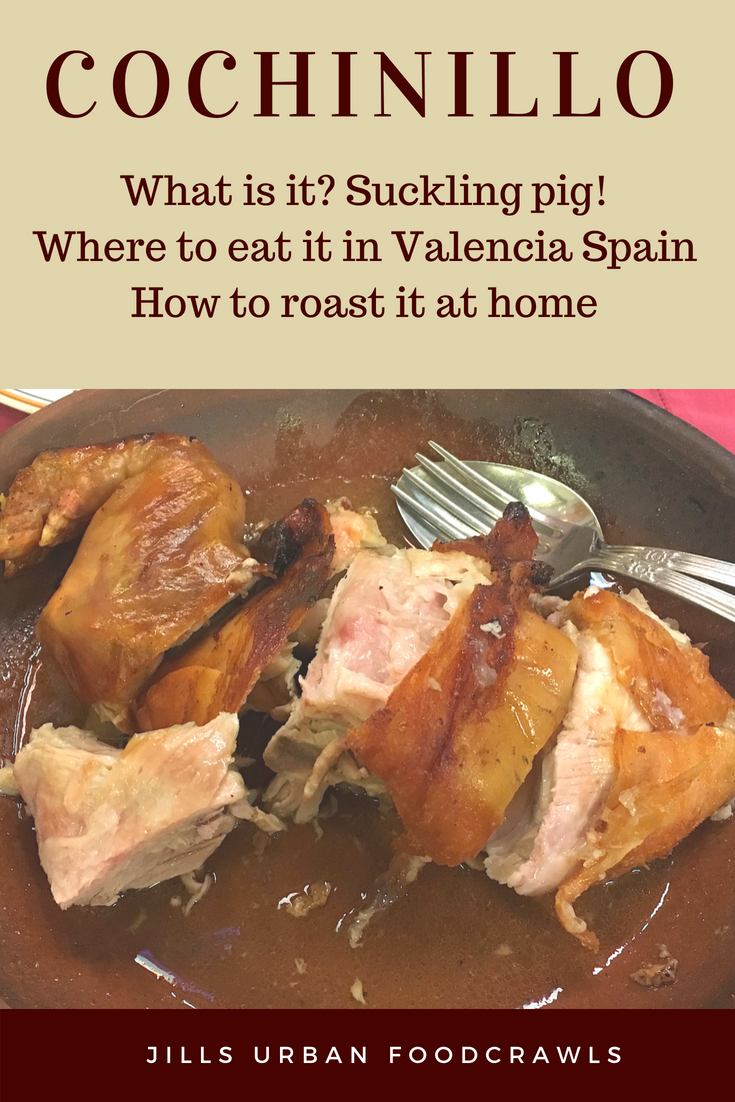
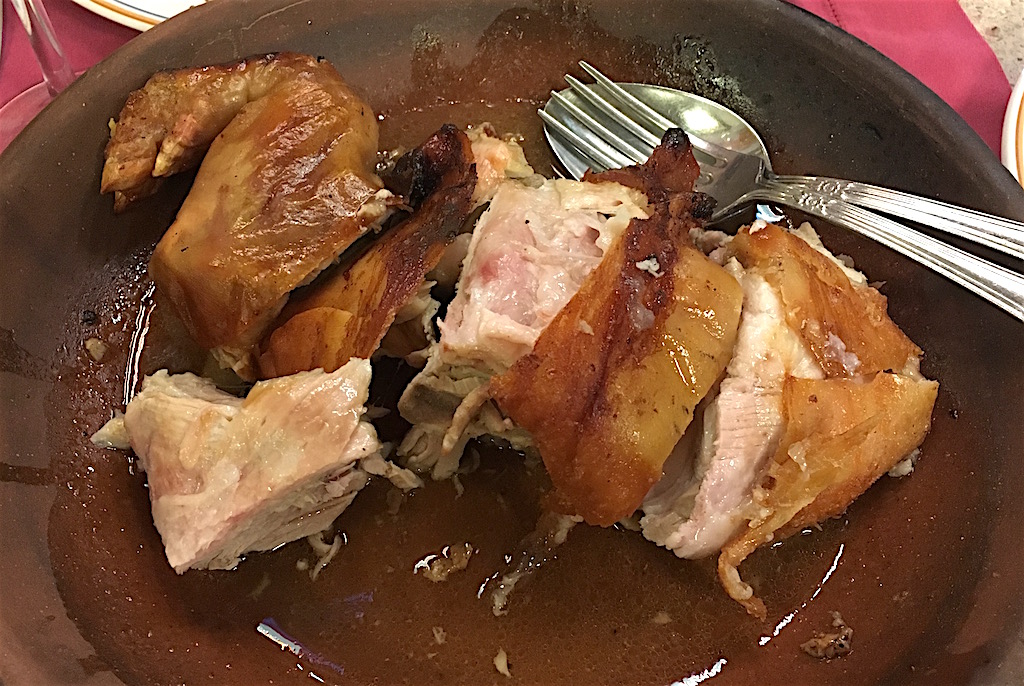





6 responses to “Cochinillo: How to Find This Porky Goodness in Valencia or Even in Your Own Kitchen”
Your blog is giving me so many great ideas for our upcoming trip to Valencia! I just booked us at Raco del Turio for a lunch in September. Thanks so much for sharing so many of your adventures.
LikeLiked by 1 person
So glad to have helped! I hope you enjoy Raco del Turio, it is a lovely restaurant and their paella was some of the best we had in Valencia.
LikeLike
That pork looks mouthwateringly good!!
LikeLiked by 1 person
It was mouthwateringly good! There is just something about juicy slow cooked pork…
LikeLiked by 1 person
Oh, yes… my wife make slow cook pork loin in the crock pot. Minni version of yours.
LikeLike
[…] For more on Spanish suckling pig, see our previous post: Cochinillo: How to Find This Porky Goodness in Valencia or Even in Your Own Kitchen […]
LikeLike